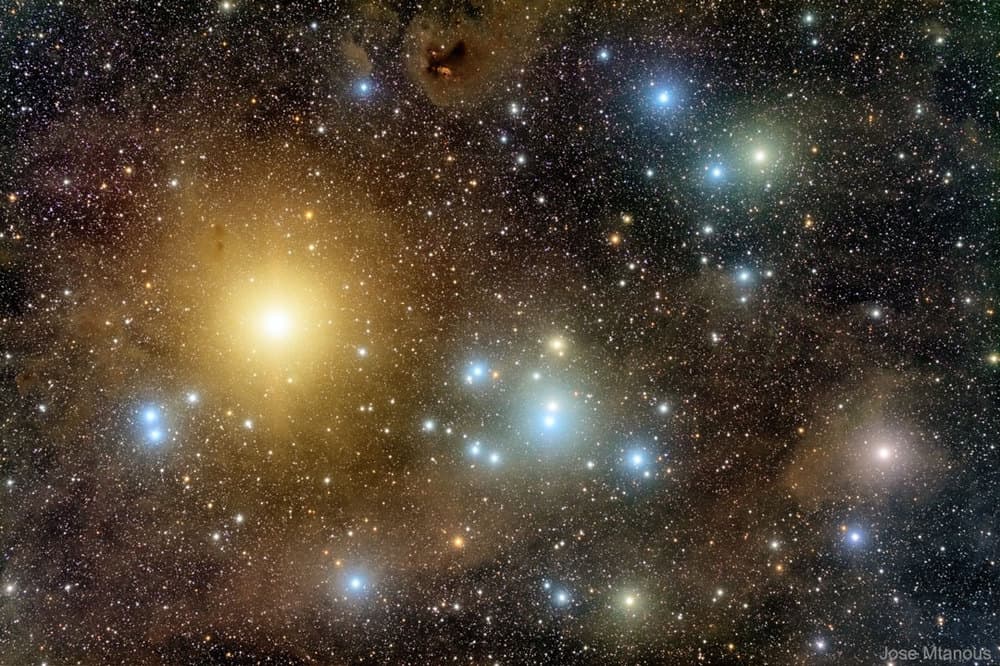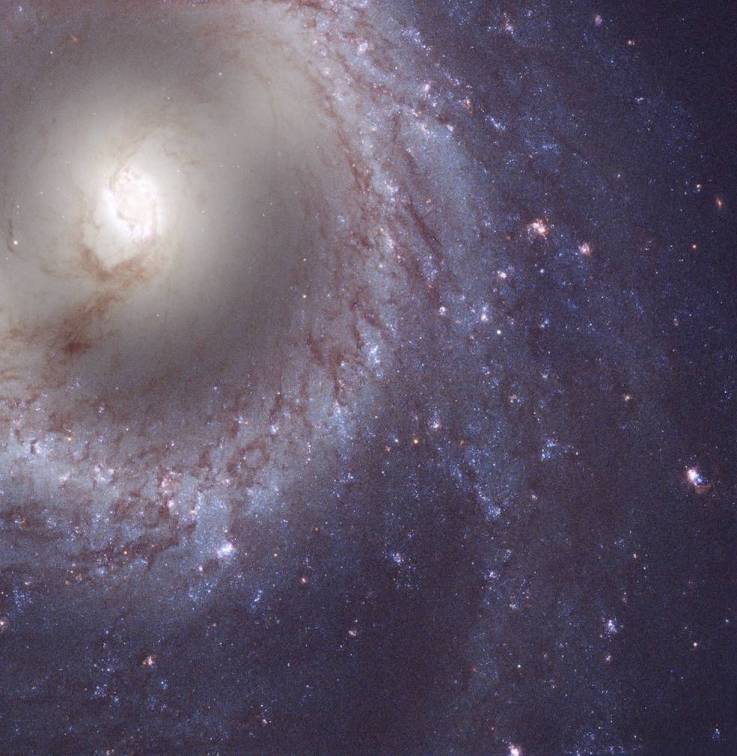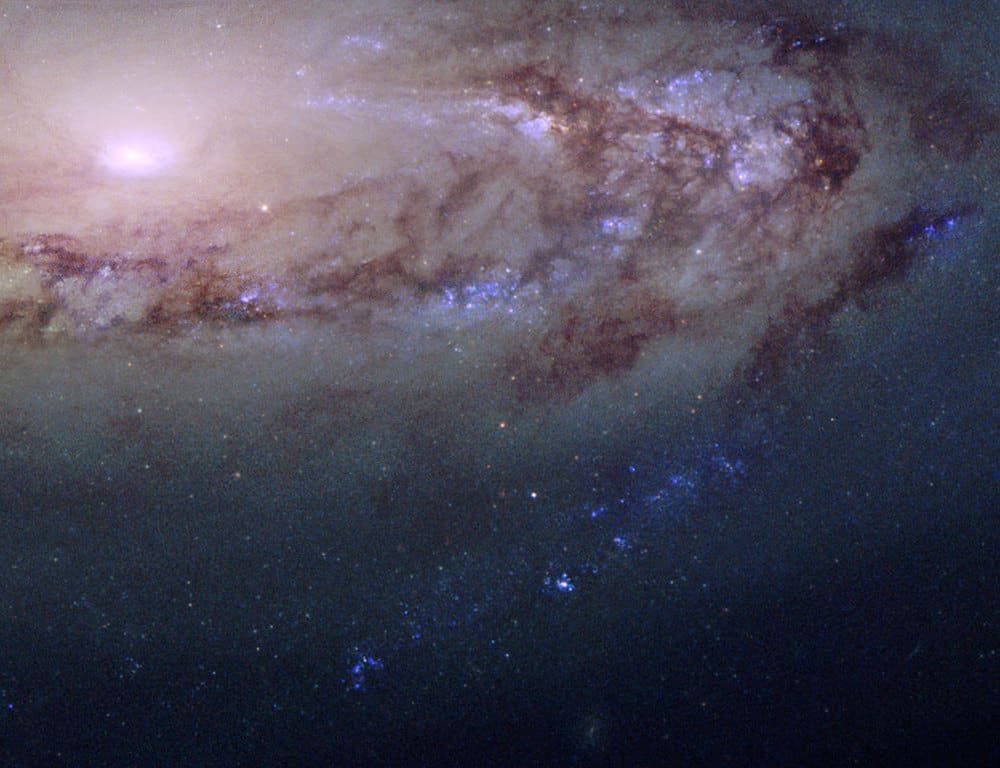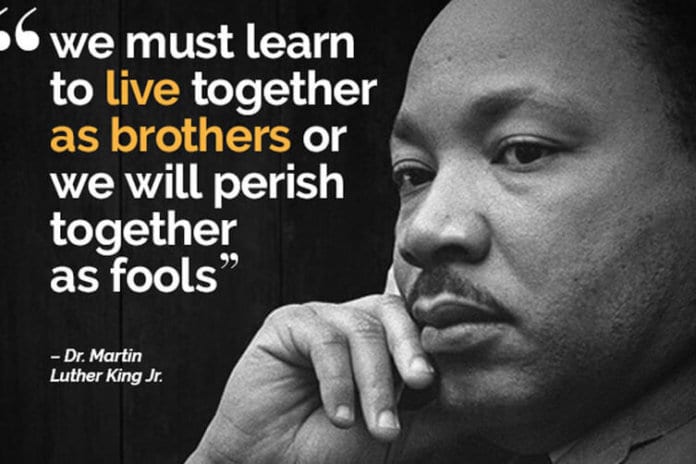Blog
It is the closest cluster of stars to the Sun. The Hyades open cluster is bright enough to have been remarked on even thousands of years ago, yet is not as bright or compact as the nearby Pleiades (M45) star cluster. Pictured here is a particularly deep image of the Hyades which has brings out vivid star colors and faint coincidental nebulas. The brightest star in the field is yellow Aldebaran, the eye of the bull toward the constellation of Taurus. Aldebaran, at 65 light-years away, is now known to be unrelated to the Hyades cluster, which lies about 150 light-years away. The central Hyades stars are spread out over about 15 light-years. Formed about 625 million years ago, the Hyades likely shares a common origin with the Beehive cluster (M44), a naked-eye open star cluster toward the constellation of Cancer, based on M44‘s motion through space and remarkably similar age.

Samuel Cook (January 22, 1931 – December 11, 1964), known professionally as Sam Cooke, was an American singer, songwriter, civil-rights activist and entrepreneur.
Influential as both a singer and composer, he is commonly known as the King of Soul for his distinctive vocals and importance within popular music. He began singing as a child and joined the Soul Stirrers before moving to a solo career where he scored a string of hit songs like “You Send Me“, “A Change Is Gonna Come“, “Wonderful World“, “Chain Gang“, “Twistin’ the Night Away“, and “Bring It On Home to Me“.
His pioneering contributions to soul music contributed to the rise of Aretha Franklin, Bobby Womack, Al Green, Curtis Mayfield, Stevie Wonder, Marvin Gaye, and Billy Preston, and popularized the likes of Otis Redding and James Brown. AllMusic biographer Bruce Eder wrote that Cooke was “the inventor of soul music”, and possessed “an incredible natural singing voice and a smooth, effortless delivery that has never been surpassed”.
On December 11, 1964, at the age of 33, Cooke was shot and killed by Bertha Franklin, the manager of the Hacienda Motel in Los Angeles, California. After an inquest, the courts ruled Cooke’s death to be a justifiable homicide. Since that time, the circumstances of his death have been called into question by Cooke’s family.
Cooke was born Samuel Cook in Clarksdale, Mississippi, in 1931 (he added the “e” to his last name in 1957 to signify a new start to his life). He was the fifth of eight children of the Rev. Charles Cook, a minister in the Church of Christ (Holiness), and his wife, Annie Mae. One of his younger brothers, L.C. (1932–2017), later became a member of the doo-wop band Johnny Keyes and the Magnificents.
The family moved to Chicago in 1933. Cook attended Doolittle Elementary and Wendell Phillips Academy High School in Chicago, the same school that Nat “King” Cole had attended a few years earlier. Sam Cooke began his career with his siblings in a group called the Singing Children when he was six years old. He first became known as lead singer with the Highway QC’s when he was a teenager, having joined the group at the age of 14. During this time, Cooke befriended fellow gospel singer and neighbor Lou Rawls, who sang in a rival gospel group. Cooke died at the age of 33 on December 11, 1964, at the Hacienda Motel, in Los Angeles, California. Answering separate reports of a shooting and of a kidnapping at the motel, police found Cooke’s body, clad only in a sports jacket and shoes but no shirt, pants or underwear. He had sustained a gunshot wound to the chest, which was later determined to have pierced his heart. The motel’s manager, Bertha Franklin, said she had shot Cooke in self-defense after he broke into her office residence and attacked her. Her account was immediately disputed by Cooke’s acquaintances.
more...James Louis Johnson (January 22, 1924 – February 4, 2001) was an American jazz trombonist, composer and arranger. Johnson was one of the earliest trombonists to embrace bebop.
After studying the piano beginning at age 9, Johnson decided to play trombone at the age of 14. In 1941, he began his professional career with Clarence Love, and then played with Snookum Russell in 1942. In Russell’s band he met the trumpeter Fats Navarro, who influenced him to play in the style of the tenor saxophonist Lester Young. Johnson played in Benny Carter‘s orchestra between 1942 and 1945, and made his first recordings in 1942 under Carter’s leadership, recording his first solo (on Love for Sale) in October 1943. In 1944, he took part in the first Jazz at the Philharmonicconcert, presented in Los Angeles and organized by Norman Granz. In 1945 he joined the big band of Count Basie, touring and recording with him until 1946.
While the trombone was featured prominently in dixieland and swing music, it fell out of favor among bebop musicians, largely because instruments with valves and keys (trumpet, saxophone) were believed to be more suited to bebop’s often rapid tempos and demand for technical mastery. In 1946, bebop co-inventor Dizzy Gillespie encouraged the young trombonist’s development with the comment, “I’ve always known that the trombone could be played different, that somebody’d catch on one of these days. Man, you’re elected.” After leaving Basie in 1946 to play in small bebop bands in New York clubs, Johnson toured in 1947 with Illinois Jacquet. During this period he also began recording as a leader of small groups featuring Max Roach, Sonny Stitt and Bud Powell. He performed with Charlie Parker at the 17 December 1947 Dial Records session following Parker’s release from Camarillo State Mental Hospital.
more...Blind Willie Johnson (January 25, 1897 – September 18, 1945) was an American gospel blues singer, guitarist and evangelist. His landmark recordings completed between 1927 and 1930—thirty songs in total—display a combination of powerful “chest voice” singing, slide guitar skills, and originality that has influenced later generations of musicians. Even though Johnson’s records sold well, as a street performer and preacher he had little wealth in his lifetime. His life was poorly documented, but over time music historians such as Samuel Charters have uncovered more about Johnson and his five recording sessions.
A revival of interest in Johnson’s music began in the 1960s, following his inclusion on Harry Smith‘s Anthology of American Folk Music, and by the efforts of the blues guitarist Reverend Gary Davis. Johnson’s work has become more accessible through compilation albums such as American Epic: The Best of Blind Willie Johnson and the Charters compilations. As a result, Johnson is credited as one of the most influential practitioners of the blues, and his slide guitar playing, particularly on his hymn “Dark Was the Night, Cold Was the Ground“, is highly acclaimed. Other recordings by Johnson include “Jesus Make Up My Dying Bed“, “It’s Nobody’s Fault but Mine“, and “John the Revelator“.
Johnson was born on January 25, 1897, in Pendleton, Texas, a small town near Waco, to sharecropper George Johnson (also identified as Willie Johnson Sr.) and his wife, Mary Fields, who died in 1901.
more...Found in the constellation Leo, M95 is a beautiful barred spiral galaxy. It was discovered in 1781 by Pierre Méchain, a colleague of Charles Messier.
This Hubble observation reveals a section of M95 featuring its central bar of stars in the upper left and one of its spiral arms extending to the lower right. The observations were taken in near-infrared, visible and ultraviolet wavelengths of light with Hubble’s Advanced Camera for Surveys and Wide Field Camera 3. Hubble took these observations of M95 to better understand star formation in nearby galaxies.
M95 is located approximately 33 million light-years away and has a magnitude of 9.7. It has around 40 billion stars. Its spiral arms host a flurry of star birth activity and sparkle with the light of countless young, blue stars. The arms themselves are very tightly wound around the galaxy’s core and are nearly circular.

Richard Pierce Havens (January 21, 1941 – April 22, 2013) was an American singer-songwriter and guitarist. His music encompassed elements of folk, soul, and rhythm and blues. He had an intense and rhythmic guitar style (often in open tunings), and played soulful covers of pop and folksongs. He was the opening act at Woodstock.
Born in Bedford–Stuyvesant, Brooklyn, Havens was the oldest of nine children. He was of Native American (Blackfoot) descent on his father’s side and of the British West Indies on his mother’s. His grandfather was Blackfoot of the Montana/South Dakota area. Havens’s grandfather and great-uncle joined Buffalo Bill’s Wild West Show, got off in New York City, and ended up on the Shinnecock Reservation in Long Island. Havens’s grandfather got married, then moved to Brooklyn.
As a youth in Bedford-Stuyvesant, Havens began organizing his neighborhood friends into street corner doo-wop groups and, at age 16, was performing with the McCrea Gospel Singers. At age 20, Havens left Brooklyn, seeking artistic stimulation in Greenwich Village. “I saw the Village as a place to escape to, in order to express yourself,” he recalled. “I had first gone there during the beatnik days of the 1950s to perform poetry, then I drew portraits for two years and stayed up all night listening to folk music in the clubs. It took a while before I thought of picking up a guitar.” Havens’s solo performances quickly spread beyond the Village folk circles. After cutting two records for Douglas Records, he signed on with Bob Dylan‘s manager, Albert Grossman, and landed a record deal with the Verve Folkways (later Verve Forecast) label. Verve released Mixed Bag in late 1966, which featured tracks such as “Handsome Johnny” (co-written by Havens and actor Louis Gossett Jr.), “Follow”, and a cover of Bob Dylan‘s “Just Like a Woman“. Havens released his first single, “No Opportunity Necessary”, in 1967.
more...Fird Eaglin Jr. (January 21, 1936 or 1937 – February 18, 2009), known as Snooks Eaglin, was an American guitarist and singer based in New Orleans. In his early years he was sometimes credited under other names, including Blind Snooks Eaglin, “Lil” Snook, Ford Eaglin, Blind Guitar Ferd.
His vocal style was reminiscent of that of Ray Charles; in the 1950s, when he was in his late teens, he sometimes billed himself as “Little Ray Charles”. He played a wide range of styles of music within the same concert, album, or even song: blues, rock and roll, jazz, country, and Latin. In his early years, he also played acoustic blues.
His ability to play a wide range of songs and make them his own earned him the nickname “The Human Jukebox.” Eaglin claimed in interviews that his musical repertoire included some 2,500 songs.
At live shows, he usually did not prepare set lists and was unpredictable, even to his bandmates. He played songs that came to him on stage, and he also took requests from the audience.
Eaglin lost his sight not long after his first birthday, having been stricken with glaucoma, and spent several years in the hospital with other ailments. Around the age of five he received a guitar from his father and taught himself to play by listening to and playing along with the radio. A mischievous youngster, he was given the nickname “Snooks” after a radio character named Baby Snooks.
In 1947, at the age of 11, Eaglin entered a talent contest organized by the radio station WNOE and won it with his performance of “Twelfth Street Rag.” Three years later, he dropped out of a school for the blind to become a professional musician. In 1952, he joined the Flamingoes, a local seven-piece band started by Allen Toussaint. The Flamingoes did not have a bass player, and according to Eaglin, he played both the guitar and the bass parts simultaneously on his guitar. He stayed with the Flamingoes for several years, until the group disbanded in the mid-1950s.
As a solo artist, his recording and touring were inconsistent, and for a man with a career of about 50 years, his discography is rather slim. His first recording was in 1953, playing guitar at a recording session for James “Sugar Boy” Crawford.
The first recordings under his own name were made by Harry Oster, a folklorist from Louisiana State University, who found Eaglin playing in the streets of New Orleans and recorded him in seven sessions between 1958 and 1960. For these recordings, Eaglin played in a folk blues style, accompanying himself on an acoustic guitar, without a band. These recordings were later released by several labels, including Folkways, Folk-Lyric, and Prestige/Bluesville.
more...María Dolores Flores Ruiz (21 January 1923 – 16 May 1995) was a Spanish singer, actress, dancer and businesswoman. Referred to as “La Faraona” since the 1950s, Lola is known for her overwhelming personality onstage. As a bailaora, she enraged several generations of continents, although she distanced herself from flamenco canons. Lola performed more than 35 films, pigeonholed, in many of them, in Andalusian folklore, although she also interpreted rumbas and rancheras.
Born and raised in Jerez de la Frontera, Lola moved to Seville in 1928.
more...M90 is a bright, beautiful spiral galaxy situated in the Virgo cluster of galaxies. Located in the constellation Virgo, this galaxy is approximately 59 million light-years away from Earth and has a magnitude of 9.5. M90 is believed to be breaking away from the rest of the galaxies in the Virgo cluster and is one of the few galaxies traveling toward our Milky Way galaxy, not away.
Charles Messier found M90 in 1781 while looking at other galaxies in the Virgo cluster. M90 contains approximately a trillion stars and a thousand globular clusters. With the exception of the inner disk region, the galaxy’s arms contain very little star formation. Interactions with neighboring galaxies likely stripped away the gas and material that M90 needs to have active star formation in its outer regions. In the future, M90 is expected to evolve into a lenticular galaxy, which is a galaxy that has qualities of both a spiral and an elliptical galaxy.
This Hubble observation was taken in infrared, ultraviolet and visible light with the telescope’s Wide Field and Planetary Camera 2. Less than half of the galaxy is visible in this image. Astronomers used these Hubble observations to help study the properties of galactic bulges and the cores of nearby galaxies.

José James (born January 20, 1978) is an American vocalist best known for performing and blending modern jazz and hip-hop. James performs all over the world both as a bandleader and with other groups.
José James attended The New School for Jazz and Contemporary Music. In 2008, he debuted with his first album, The Dreamer, on the Brownswood label. Blackmagic followed in 2010. 2010’s For All We Know came out on the Impulse! label. For All We Know became the winner of both the Edison Award and L’Académie du Jazz Grand Prix for best Vocal Jazz Album of 2010.
more...Jeff “Tain” Watts (born January 20, 1960) is a jazz drummer who has performed with Wynton Marsalis, Branford Marsalis, Betty Carter, Michael Brecker, Alice Coltrane, Ravi Coltrane, and others.
Watts got the nickname “Tain” from Kenny Kirkland when they were on tour in Florida and drove past a Chieftain gas station. He was given a Guggenheim fellowship in music composition in 2017.
https://www.youtube.com/watch?v=5p3V5aEtDqQ
more...Wilbur James Cobb (born January 20, 1929) is an American jazz drummer. Some of Cobb’s most famous work is on Miles Davis‘s Kind of Blue (1959). Cobb is the last surviving player from the session. He also played on other Davis albums, including Sketches of Spain, Someday My Prince Will Come, Miles Davis at Carnegie Hall, In Person Friday and Saturday Nights at the Blackhawk, Complete, and briefly on Porgy and Bess and Sorcerer.
He has worked with Dinah Washington, Pearl Bailey, Clark Terry, Cannonball Adderley, Dizzy Gillespie, John Coltrane, Sarah Vaughan, Billie Holiday, Wynton Kelly, Stan Getz, Wes Montgomery, Art Pepper, Gil Evans, Miles Davis, Paul Chambers, Kenny Burrell, J. J. Johnson, Sonny Stitt, Nat Adderley, Benny Golson, Hank Jones, Ron Carter, George Coleman, Fathead Newman, Geri Allen, Earl Bostic, Leo Parker, Charlie Rouse, Ernie Royal, Philly Joe Jones, Bobby Timmons, Walter Booker, Jerome Richardson, Keter Betts, Jimmy Cleveland, Sam Jones, Red Garland, Joe Henderson, Eddie Gómez, Bill Evans, Jeremy Steig, Richard Wyands, Peter Bernstein, Richie Cole, Nancy Wilson, Ricky Ford.
more...Huddie William Ledbetter (/ˈhjuːdi/; January 20, 1888 – December 6, 1949), better known by the stage name Lead Belly, was an American folkand blues singer, musician and songwriter notable for his strong vocals, virtuosity on the twelve-string guitar, and the folk standards he introduced, including his renditions of “Goodnight, Irene“, “Midnight Special“, “Cotton Fields“, and “Boll Weevil“.
Lead Belly usually played a twelve-string guitar, but he also played the piano, mandolin, harmonica, violin, and windjammer. In some of his recordings, he sang while clapping his hands or stomping his foot.
Lead Belly’s songs covered a wide range of genres and topics including gospel music; blues about women, liquor, prison life, and racism; and folk songs about cowboys, prison, work, sailors, cattle herding, and dancing. He also wrote songs about people in the news, such as Franklin D. Roosevelt, Adolf Hitler, Jean Harlow, Jack Johnson, the Scottsboro Boys and Howard Hughes. Lead Belly was posthumously inducted into the Rock and Roll Hall of Fame in 1988 and the Louisiana Music Hall of Fame in 2008.
Though many releases credit him as “Leadbelly”, he himself wrote it as “Lead Belly”, which is also the spelling on his tombstone and the spelling used by the Lead Belly Foundation.
Lead Belly pronounced his first name /ˈhjuːdi/ (HYOO-dee, as if spelled “Hudie”). He can be heard pronouncing his name this way on one of his recordings of “Boll Weevil”.The younger of two children, Lead Belly was born Huddie William Ledbetter to Sallie Brown and Wesley Ledbetter on a plantation near Mooringsport, Louisiana, on January 20, 1888. His parents had cohabited for several years, but they legally married on February 26, 1888. When Huddie was five years old, the family settled in Bowie County, Texas. The 1900 United States Census lists “Hudy Ledbetter” as 12 years old, born January 1888, and the 1910 and 1930 censuses also give his age as corresponding to a birth in 1888. The 1940 census lists his age as 51, with information supplied by wife Martha. However, in April 1942, when Ledbetter filled out his World War II draft registration card, he gave his birth date as January 23, 1889, and his birthplace as Freeport, Louisiana(“Shreveport”). His grave marker bears the date given on his draft registration.
more...https://www.youtube.com/watch?v=lw2f235y7k0
more...More Posts
- Willie Dixon Day
- World Music with Music Maya Aj
- Daily Roots with Horace Andy
- The Cosmos with Trapezium Cluster
- Stanley Clarke Day
- Andrew Hill Day
- World Music with Nico Kasanda
- Daily Roots with Hortense Ellis
- The Cosmos with M24
- Gilberto Gil Day
- Julian Priester Day
- World Music with Paco De Lucia
- Daily Roots with Alton Ellis & the Heptones
- The Cosmos with Sharpless 2-106
- John Medeski Day
- David Honeyboy Edwards Day
- World Music with Odpoczno
- Daily Roots with Ras Tweed
- The Cosmos with M8
- Johnny “Big Moose” Walker Day
